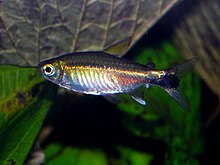
The neon tetra is a freshwater fish of the characin family of order Characiformes. The type species of its genus, it is native to blackwater and clearwater streams in the Amazon basin of South America. Its bright colouring makes the fish visible to conspecifics in the dark blackwater streams, and is also the main reason for its popularity among freshwater fish hobbyists, with neon tetras being one of the most widely kept tropical fish in the world.

The Amazon basin is the part of South America drained by the Amazon River and its tributaries. The Amazon drainage basin covers an area of about 7,000,000 km2 (2,700,000 sq mi), or about 35.5 percent of the South American continent. It is located in the countries of Bolivia, Brazil, Colombia, Ecuador, Guyana, Peru, Suriname, and Venezuela, as well as the territory of French Guiana.
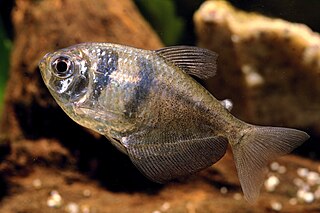
The black tetra, also known as the black skirt tetra, petticoat tetra, high-fin black skirt tetra, black widow tetra and blackamoor, is a freshwater fish of the characin family (Characidae).

The cardinal tetra is a freshwater fish of the family Characidae of order Characiformes. It is native to the upper Orinoco and Negro Rivers in South America. Growing to about 3 cm (1.2 in) total length, the cardinal tetra has the striking iridescent blue line characteristic of the genus Paracheirodon laterally bisecting the fish, with the body below this line being vivid red in color, hence the name "cardinal tetra". The cardinal tetra's appearance is similar to that of the closely related neon tetra, with which it is often confused; the neon's red coloration extends only about halfway to the nose, and the neon's blue stripe is a less vibrant blue.

Tetra is the common name of many small freshwater characiform fishes. Tetras come from Africa, Central America, and South America, belonging to the biological family Characidae and to its former subfamilies Alestidae and Lebiasinidae. The Characidae are distinguished from other fish by the presence of a small adipose fin between the dorsal and caudal fins. Many of these, such as the neon tetra, are brightly colored and easy to keep in captivity. Consequently, they are extremely popular for home aquaria.

The black neon tetra is a freshwater fish of the characin family (Characidae) of the order Characiformes. It is native to the Paraguay basin of southern Brazil. They are often found in the aquarium trade.

Hyphessobrycon is a genus of freshwater fish in the family Characidae. These species are among the fishes known as tetras. The genus is distributed in the Neotropical realm from southern Mexico to Río de la Plata in Argentina. Many of these species are native to South America; about six species are from Central America and a single species, H. compressus is from southern Mexico.

The rummy-nose tetra is a species of tropical freshwater characin fish originating in South America, popular among fishkeepers as a tropical aquarium fish. One of many small tetras belonging to the same genus, it is on average 5 cm (2 in) long when fully grown. The fish is one of several very similar species including Petitella bleheri, and Petitella georgiae, and it is possible that more recently collected specimens available in the aquarium trade are members of one or other of these similar species. The common name applied to most of these fishes is "rummy-nose tetra", though other common names are in circulation.

Thayeria boehlkei is a species of characin fish endemic to the Amazon river basin and Araguaia river, in Peru and Brazil respectively. The species is popular with aquarium hobbyists where it is traded under a variety of common names including blackline penguinfish, blackline thayeria, hockey-stick tetra, penguin fish and penguin tetra.
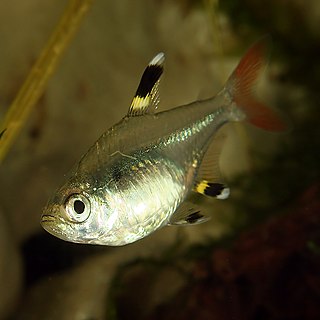
Pristella maxillaris is a species of characin in the genus Pristella, and is commonly known as the X-ray fish or X-ray tetra because of its translucent body.
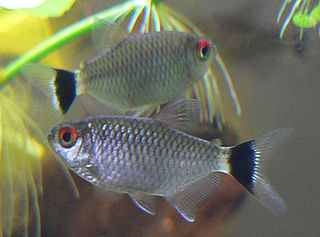
The redeye tetra, is a species of tetra from the São Francisco, upper Paraná, Paraguay and Uruguay river basins in eastern and central South America. This freshwater fish is commonly kept in aquariums and bred in large numbers at commercial facilities in Eastern Europe and Asia. The redeye tetra is one of the more popular aquarium fish due to their schooling capability.

The ember tetra is a freshwater fish of the characin family of order Characiformes. It is native to the Araguaia River basin of Brazil and was discovered in 1987 and named in honor of the fish explorer Heiko Bleher's mother.

Myloplus schomburgkii, also known as the Disk tetra, Disk pacu, Black-ear pacu, Black-band myleus or Black-barred myleus is a species of serrasalmid with a black bar on its side. This species is found in the middle and lower Amazon River basin, Nanay River, upper Orinoco River basin in Brazil, Peru, Venezuela and possibly in Suriname.
Hyphessobrycon heterorhabdus, commonly known as the flag tetra or Belgian flag tetra, is a species of freshwater characin fish endemic to Brazil. Belonging to the family Characidae, this species is distinguished by its vibrant coloration and patterns, which have contributed to its popularity in the aquarium trade.

Hemigrammus is a genus of freshwater fish in the family Characidae native to South America and commonly seen in the aquarium trade. These are medium-small tetras where the largest species reach up to around 11 cm (4.3 in).

Petitella georgiae, the false rummy-nose tetra, is a species of characin found in Amazon Basin in Brazil and Peru. It is a very popular aquarium fish. It resembles two species from its genus, Petitella bleheri and Petitella rhodostoma. It is distributed in the upper Amazon basin in Peru, Rio Purus, Rio Negro, and Rio Madeira basins. Some specimens have a black stripe in the caudal peduncle extending forwards into the body, surmounted above by a thin iridescent gold line; however, whether this feature is a reliable determinant of species identity has yet to be fully ascertained.
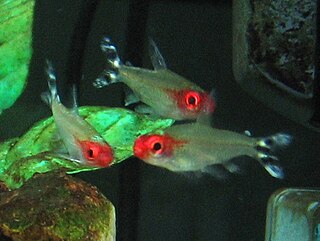
Petitella bleheri is a species of characin found in Amazon Basin in Brazil and Peru. One of three species called rummy-nose tetra, but is also called firehead tetra according to FishBase. Reaching a standard length of 2 in (5 cm) it is a common species found in the aquarium trade although often potentially hybridised with the other collective rummy-nose tetra species Petitella rhodostomus and Petitella georgiae; the false rummy-nose tetra.

Hyphessobrycon bentosi, the Bentos tetra, ornate tetra or candy cane tetra, is a species of characin fish found in sluggish tributaries at the Amazon Basin in Brazil and Peru. Occasionally, it makes its way into the aquarium trade. It has often been confused with the rosy tetra.

Hyphessobrycon agulha is a species of tetra in the family Characidae. As a freshwater fish, it inhabits the basin of the Madeira River in Brazil along with parts of Peru and Bolivia, and it reaches a maximum length of 4.3 centimetres (1.7 in). Though it is mainly found in the wild, it is occasionally kept by fishkeepers and is sometimes confused with the neon tetra. The fish is primarily an insectivore, though it does eat vegetable matter. It is considered to form a group with other species in Hyphessobrycon as they share a dark stripe running lengthwise.
